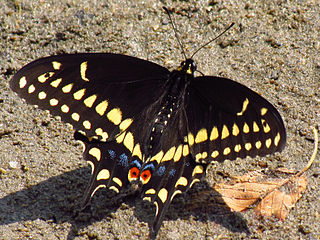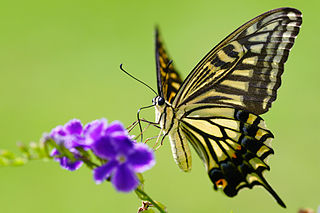
A pupa is the life stage of some insects undergoing transformation between immature and mature stages. Insects that go through a pupal stage are holometabolous: they go through four distinct stages in their life cycle, the stages thereof being egg, larva, pupa, and imago. The processes of entering and completing the pupal stage are controlled by the insect's hormones, especially juvenile hormone, prothoracicotropic hormone, and ecdysone. The act of becoming a pupa is called pupation, and the act of emerging from the pupal case is called eclosion or emergence.

Papilio polyxenes, the (eastern) black swallowtail, American swallowtail or parsnip swallowtail, is a butterfly found throughout much of North America. An extremely similar-appearing species, Papilio joanae, occurs in the Ozark Mountains region, but it appears to be closely related to Papilio machaon, rather than P. polyxenes. The species is named after the figure in Greek mythology, Polyxena, who was the youngest daughter of King Priam of Troy. Its caterpillar is called the parsley worm because the caterpillar feeds on parsley.

The black garden ant, also known as the common black ant, is a formicine ant, the type species of the subgenus Lasius, which is found across Europe and in some parts of North America, South America, Asia and Australasia. The European species was split into two species; L. niger, which are found in open areas; and L. platythorax, which is found in forest habitats. It is monogynous, meaning colonies contain a single queen.

The common blue butterfly or European common blue is a butterfly in the family Lycaenidae and subfamily Polyommatinae. The butterfly is found throughout the Palearctic and has been introduced to North America. Butterflies in the Polyommatinae are collectively called blues, from the coloring of the wings. Common blue males usually have wings that are blue above with a black-brown border and a white fringe. The females are usually brown above with a blue dusting and orange spots.

Lycaenidae is the second-largest family of butterflies, with over 6,000 species worldwide, whose members are also called gossamer-winged butterflies. They constitute about 30% of the known butterfly species.

Gonepteryx rhamni, commonly named the common brimstone, is a butterfly of the family Pieridae. It lives throughout the Palearctic zone and is commonly found across Europe, Asia, and North Africa. Across much of its range, it is the only species of its genus, and is therefore simply known locally as the brimstone. Its wing span size is 60–74 mm (2.4–2.9 in). It should not be confused with the brimstone moth Opisthograptis luteolata.

The great purple hairstreak, also called the great blue hairstreak, is a common gossamer-winged butterfly species in parts of the United States. It is actually a Neotropical species; its North American range only includes the warm-temperate and subtropical parts of that continent, and it ranges southwards almost to the Isthmus of Panama. The type specimen, however, was shipped to Europe from the Colony of Virginia, probably around the time of the United States Declaration of Independence.

The silver-studded blue is a butterfly in the family Lycaenidae. It has bright blue wings rimmed in black with white edges and silver spots on its hindwings, lending it the name of the silver-studded blue. P. argus can be found across Europe and east across the Palearctic, but it is most often studied in the United Kingdom where the species has experienced a severe decline in population due to habitat loss and fragmentation.

The marsh fritillary is a butterfly of the family Nymphalidae. Commonly distributed in the Palearctic region, the marsh fritillary's common name derives from one of its several habitats, marshland. The prolonged larval stage lasts for approximately seven to eight months and includes a period of hibernation over the winter. The larvae are dependent on the host food plant Succisa pratensis not only for feeding but also for hibernation, because silken webs are formed on the host plant as the gregarious larvae enter hibernation. Females lay eggs in batches on the host plant and are, like other batch-layers, selective about the location of oviposition because offspring survivorship levels for batch-layers are more tied to location selection than they are for single-egg layers.

Phengaris alcon, the Alcon blue or Alcon large blue, is a butterfly of the family Lycaenidae and is found in Europe and across the Palearctic to Siberia and Mongolia.

The Eucharitidae are a family of parasitic wasps. Eucharitid wasps are members of the superfamily Chalcidoidea and consist of three subfamilies: Oraseminae, Eucharitinae, and Gollumiellinae. Most of the 55 genera and 417 species of Eucharitidae are members of the subfamilies Oraseminae and Eucharitinae, and are found in tropical regions of the world.

Papilio demodocus, the citrus swallowtail or Christmas butterfly, is a swallowtail butterfly which commonly occurs over the entirety of sub-Saharan Africa, including Madagascar, besides the southern Arabian Peninsula. The caterpillars feed on various native plants of especially the family Rutaceae, but have also taken to the leaves of cultivated citrus trees.

Myrmecophily is the term applied to positive interspecies associations between ants and a variety of other organisms, such as plants, other arthropods, and fungi. Myrmecophily refers to mutualistic associations with ants, though in its more general use, the term may also refer to commensal or even parasitic interactions.

Iridomyrmex is a genus of ants called rainbow ants first described by Austrian entomologist Gustav Mayr in 1862. He placed the genus in the subfamily Dolichoderinae of the family Formicidae. It has 79 described species and five fossil species. Most of these ants are native to Australia; others are found in Asia and Oceania, and they have been introduced to Brazil, New Zealand, and the United Arab Emirates. Fossil species are known from China, France, and the United States.

Papilio xuthus, the Asian swallowtail, Chinese yellow swallowtail or Xuthus swallowtail, is a yellow-colored, medium to large sized swallowtail butterfly found in northeast Asia, northern Myanmar, southern China, Taiwan, the Korean Peninsula, Japan, Siberia and the Hawaiian Islands. It was also recorded in the state of Arunachal Pradesh, India, in 2014.

Jalmenus inous, the Inous blue or varied hairstreak, is a butterfly of the family Lycaenidae. It is endemic to coastal Western Australia.

Eucheira socialis, commonly known as the Madrone butterfly is a lepidopteran that belongs to the family Pieridae. It was first described by John O. Westwood in 1834. Locally known as Mariposa del madroño or tzauhquiocuilin, it is endemic to the highlands of Mexico, and exclusively relies on the Madrone as a host-plant. The species is of considerable interest to lepidopterists due to gregarious nest-building in the larval stages, and heavily male-biased sex ratio. It takes an entire year for this adult butterfly to develop from an egg. The eggs are laid in the month of June and the adults emerge the following May–June. The adults have a black and white pattern on their wings, and the males are generally much smaller and paler than the females. The larvae do not undergo diapause and continue to feed and grow communally in the coldest months of the year. There are two subspecies of E. socialis, named E. socialis socialis and E. socialis westwoodi.

Iridomyrmex anceps is an ant species of the genus Iridomyrmex. It has a very large distribution on multiple continents, but it is mainly distributed in northern Australia. Some specimens were found on multiple islands, and some were even found and collected in the United Arab Emirates.

Mischocyttarus flavitarsis is a social paper wasp found in western North America. Their nests can be found both in forests close to rivers or in close proximity to human life under the eaves of roofs. Despite the fact that M. flavitarsis nests are frequently in close contact with humans, M. flavitarsis typically will not sting, but rather ram into the threatening individual. Their colony cycle typically begins before May and will last until October. The queen will then seek a hibernation site for the winter. Perched near female hibernation sites are males with whom the female will mate. The males have claimed their territory by rubbing sternal brushes along the border of the site, leaving a chemical that deters other individuals from approaching. M. flavitarsis feed on arthropods, nectar, and animal carcasses and are often prey to birds, ants, and praying mantis.
Liriomyza trifolii, known generally as the American serpentine leafminer or celery leafminer, is a species of leaf miner fly in the family Agromyzidae.




























